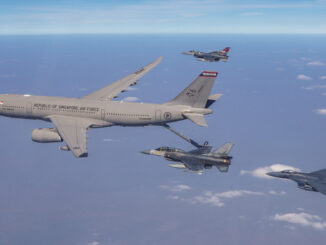
Maiden flight of Airbus A400M Atlas
Someday in the early 1980s, an idea of European transport aeroplane was born. At that time, Transall C-160 and Lockheed C-130 Hercules were the backbone of military airlifting in the Western countries, both being designed decades ago and introduced in 1967 and 1956 respectively.
This idea hit on the fertile ground and already in 1982 the FIMA (Future International Military Airlifter) joint-venture was established by Aérospatiale, British Aerospace, Lockheed and Messerschmitt-Bölkow-Blohm companies.
At the beginning, all seemed very promising and the first study led to project of four-engine, high-wing aeroplane with a T-shape tail. Market forecasts showed an expected demand for almost 1,000 of such aircraft and the future airlifter had to be produced simultaneously in Europe and the USA. In addition, the Independent European Project Group (IEPG – a multinational agency established outside the military structures and aimed for supporting a range of projects and initiatives) not only promised a significant support for FIMA, but also introduced further plans of using the future airlifter for air-to-air refuelling and other missions.
Regrettably, as often is the case, the initially successful development of joint military airlifter was shortly slowed down. Despite the nice beginning, involving IEPG into the project turned out to be a big mistake as it brought not only conflicting requirements coming from participating countries, but most of all, political tensions. As a result, Lockheed decided to leave the FIMA group in 1989 and focused on its own development, C-130J Super Hercules.
Two years later, a few further aviation companies joined the project (Alenia Aeronautica, CASA, OGMA, Sabca and TAI) and the FIMA initiative was transferred into Euroflag – European Future Large Aircraft Group, a new joint-venture company based in Rome. In the meantime, the military authorities of future customers were still discussing the requirements for new airlifter. It could seem unbelievable, but this task – all that time being affected by politics – took them another five years and the so-called European Staff Requirement document was finalized only in 1996. Finally, the new European military cargo aeroplane had to be four-engine, turbofan-powered aircraft, significantly exceeding the C-130 in terms of payload, speed and range. It was then expected that the new airlifter would be introduced no later than in 2008.
In the middle of 1990s, the European initiative faced another challenge. The new American airlifter – C-17 Globemaster being developed by McDonnell-Douglas, parallelly with the European future aircraft – was not only challenged by various buildout difficulties but also turned out to be extremely expensive. As a result, McDonnell-Douglas was trying to find a European partner for this project, for some time focusing on France and using both economic and political lobbying in support of C-17. Fortunately for Euroflag, no European country yielded to much bigger but also expensive aeroplane.
And in the late 1990s another threat appeared and it was military budget cuts caused by the end of the Cold War. Countries participating in the Euroflag initiative were either reducing the initial order forecasts or withdrawing from the project. And again, the politics was among the most dangerous enemies of the multinational programme – it should be mentioned here that, for example, the German MoD considered the Antonov An-70 as the German future airlifter.
A very tangible step forward the new aircraft was done in May 2003, when the task of creating the new airlifter was assigned by OCCAR (Organisation for Joint Armament Cooperation) to Airbus Military. At that time, the project was supported by seven countries (Belgium, France, Germany, Luxembourg, Spain, Turkey and the UK) and order forecast was defined as approximately 180 aeroplanes (from now on officially called A400M). In 2005, Malaysia joined the European initiative, as the only country outside NATO.
Finally, after years of complicated and politically-affected development, the new European airlifter took-off for its maiden flight on 11th December 2009, at Seville. However, at that time it was also obvious that the initial delivery schedule could not be met, which caused another issues and almost led to abandoning the project at its final stage.
It was reported that UK and France already discussed the potential deliveries of C-130J, Luftwaffe was looking for another alternative, South Africa joined the project for a while, then withdrawing and cancelling all orders, and – last but not least – the programme was not only behind the schedule but also 5 billion EUR over the budget. As a result, Airbus company suggested the programme to be cancelled and – as a direct result of such decision – all the investment lost, if the participating European governments did not wake up, decide what they want to do with the project and provide the additional funds to finalize it.
Eventually, on 5th November 2010, Belgium, Britain, France, Germany, Luxembourg, Spain and Turkey signed the delivery agreement with Airbus and financed the final stage of development. In the meantime, the A400M programme was constantly and widely criticized by many politicians and then by media.
Serial production of A400M was finally launched on 12th January 2011 and the first operational aircraft was delivered to France in August 2013, Turkey followed later that year, Malaysia in 2015 and Germany in 2016.
Currently, there are almost one hundred A400M already delivered to all eight countries participating in the programme. The latest deliveries included Belgium and Luxembourg, where the new transport aircraft entered service this year.
The Airbus A400M Atlas airlifter was already been used operationally by the French and Turkish Air Forces in Afghanistan, the Central African Republic, African Sahel Region, Mali and during operations over Iraq and Syria.



